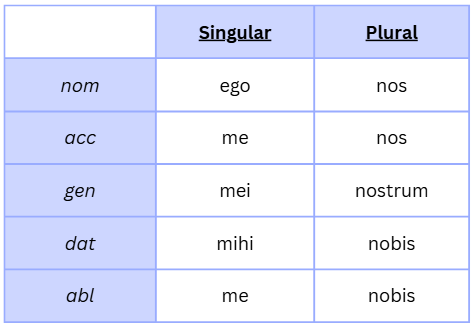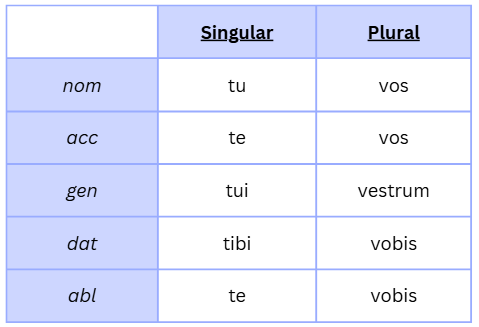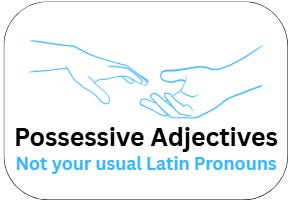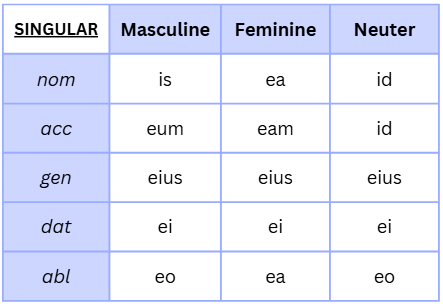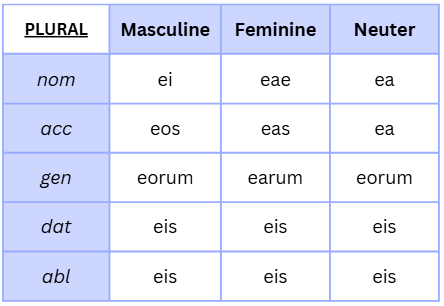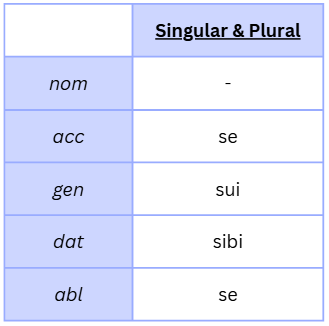Pronouns
What to do when Latin gets Personal
Today I'm going to be talking all about Latin pronouns. How they work, what they are for, and why they are important!
To help you out on your Latin journey, download my 3 Simple Steps to Instantly Improve your Latin Translations here. It's a free guide that has just a few ideas on how you can immediately take your Latin translations from doing okay to being really good.
You can also pop your email in this box and get it sent straight to you, along with all my other free guides.
What are pronouns?
Well, they are used in place of a noun. If I had a sentence, “the girl sees the boy”, I don't want to then say, “the girl greets the boy” the next sentence along. I would rather say “The girl sees the boy. She greets him”.
So they're used to avoid repetition, and they can be used in basic sentences as well as to make more complex sentences. So we're going to have a look at them in Latin today. Let's start with the first person.
1st Person Pronouns
In English, this is “I” and “we”. I is singular, and we is plural.
Here is my table for first person pronouns in Latin:
As you can see, they change in case and number. If I am in charge, I use ego, but if I'm in the accusative, if I'm the object of the sentence, I would say me. It's exactly the same as in English. “You greet me” is the same as me salutas in Latin.
Here are some notes:
Nominatives are only really used for emphasis.
That's because in Latin, the verbs tell us who does the action anyway so I don't need a pronoun as well. But if I want to say “I greet someone”, that's when I use ego, or to highlight that “we know the truth”, that's when I use nos.
The genitive pronoun is only really used for partitive genitives (find this post here) and objective genitives, which is when a verb “takes the genitive”.
That's because there is something called the possessive adjective. We'll get onto those later.
For the ablatives me and nobis, if they're an ablative of accompaniment, the sentence needs the word cum as well.
However, it is not cum me or cum nobis. They combine with the word cum and we get mecum or nobiscum.
You can read my post all about ablatives here for more information on ablatives of accompaniment.
Using First Person Pronouns
Let's have a look at some examples of the first person.
ego laeta sum.
I am happy
Now, as I said, ego the pronoun is only really used for emphasis. So this means I am happy, as opposed to someone else who maybe is not quite as happy.
Romani nos vicerunt.
The Romans defeated us
Now, this could mean “we Romans defeated”, but it doesn't say what we defeated. Therefore I assume nos is accusative rather than nominative, as it's more likely to be “the Romans defeated us”. Remember, nos can be nominative and accusative in the plural first person.
puellae nobiscum ambulant.
The girls are walking with us.
Here the ablative nobis has been combined with cum because it is an ablative of accompaniment.
2nd Person Pronouns
In English this is “you” for both singular and plural. Latin needs different words:
All the same notes apply to this as the 1st person:
The nominative is used for emphasis.
The genitive is used for the partitive and the objective genitives
The ablative of accompaniment combines with cum to make tecum or vobiscum
Now for the second person, you also have the vocative case. It's identical to the nominative form in the table above. We didn't have it for the first person because you can't talk to yourself very easily. But the second person is definitely used for the vocative. You do something - you, I'm talking to you. So we definitely need vocative in this one for when we directly address people without using their name. This is the only pronoun that actually does have vocative.
Possessive Adjectives
Now, there's a reason that genitive pronoun is only used for partitive and objective genitives, and that is because we have something called possessive adjectives in Latin.
These are used in place of the genitive pronouns. They are far more common than the genitive pronoun, and they follow the regular 2-1-2 adjective endings so they're actually quite easy to spot, but it does mean there are a lot of them to remember.
My next post will be all about possessive adjectives, so make sure you’ve subscribed to get that sent straight to your inbox next week
3rd Person Pronouns
We are going to leave possessive adjectives for now then, and we're going to move on to third person pronouns. Third person pronouns are he, she, it, and they.
The girl saw the boy. She greeted him.
In this case, I have two pronouns in the second sentence. She, which is referring to the girl, and him referring to the boy. In English this is quite easy to spot because she is feminine, as is “the girl”, and “the boy” is masculine, as is him.
Let's change that second sentence.
The girl saw the boy. He greeted her.
In English it is very easy to spot the difference between the first set of sentences and this one. He is masculine, so goes with “the boy” and her is feminine, so goes with “the girl”.
Let's look at a similar sentence in Latin.
puella puerum vidit. eum salutat.
The girl saw the boy. She greets him.
Now this is just as easy to see as the English sentence, but it will take a little explaining.
eum is a third person pronoun. It ends with -um which shows it is accusative masculine singular. That tells me that it goes with puerum from the first sentence, as he is masculine singular, and it also tells me that he is not in charge of the second sentence.
So I still do not have a nominative for my second sentence. salutat is a third person singular verb. This tells me that my nominative is “he, she or it”. From my first sentence I had “the girl sees the boy”. Now I have “something greets him” because eum is masculine. So this by context means “she greets him”.
Third Person Pronouns
Here are my third person pronouns:
Often you will hear people call this table “is ea id”. The third person pronoun has become a little bit like an adjective, in that it needs to be able to agree with all nouns. So we need all the cases, all the genders and both singular and plural options.
NB: There is no vocative case, like the first person pronoun table.
The plural should be easy to learn as these follow the regular 2-1-2 adjective endings, so that's quite nice. There's not a lot of new things to learn here. It's just to be aware that they exist. In the plural they mean “they”, or they can mean “those people” or “those things”. Notice also that the neuter follows my rule:
Remember, remember every day, neuter plurals end in -a.
Gender Difficulties
Now, some of you might be thinking, okay, I get “the girl saw the boy”, that's easy to spot because of the different genders, but what if I have this sentence?
The girl saw the woman. She greeted her.
Now who is greeting who in this sentence? It's a little bit confusing. Because of context we would have to imagine that as the girl saw the woman, therefore the girl also greeted the woman. But we don't know.
It could well mean “the woman greeted the girl”.
Latin is just as ambiguous,
puella feminam vidit. eam salutat.
eam is accusative feminine singular. And so it could agree with either puella or femina, both being feminine singular nouns. It all depends who makes most sense to be doing the greeting.
So it is just as ambiguous as the English. In this case, I would say from context it probably makes more sense that the girl is greeting the woman. We haven't necessarily had a change in nominative, so just keep in mind that you do sometimes have to make a judgment call even with the help of pronouns.
Reflexive Pronouns
Let's talk about reflexive pronouns. Reflexive pronouns are used to reflect upon the original subject, so I saw myself in the mirror.
First and second person pronouns can be used reflexively:
me paro: “I prepare myself”
vos servatis: “you save yourselves”.
Both of these can be used to talk about the same person who is doing the verb.
However, third person pronouns (is ea id) cannot be used reflexively.
uxor eam necat: “the wife kills her”
In this sentence, the wife has killed a different woman, someone else, indicated by eam. That means if we want a third person to be used reflexively, to do something to themselves, we need a new set of pronouns.
These are the third person reflexives:
Now, the good thing about the third person reflexives is there is no nominative because you've already used the nominative in the original sentence.
There is only one set of endings for all genders and numbers, so you only have four extra words to learn for all the third person reflexives. se means himself, herself, itself, and themselves! How versatile!
The ablatives group with cum just as the personal pronouns do. secum means “with him/herself”, and it can also mean “with themselves”.
Look at these pairs of sentences:
uxor eam necat: The wife kills her.
uxor se necat: The wife kills herself.
The first uses is ea id, the third person pronoun. The wife kills someone else, another woman (as eam is feminine). The second sentence uses the reflexive third person pronoun se. se is an accusative, as she is the object, but it is referring back to the nominative uxor. It is reflecting back to her. It is a reflexive pronoun.
donum ei dat: He gives the gift to him.
donum sibi dat: He gives the gift to himself.
The first man gives to someone else, shown by ei in the dative, to someone other than himself.
The second gives to sibi. This is a reflexive pronoun. It's referring back to whoever is the subject of dat. “Himself”. Don't forget sibi could also be feminine - “she gives the gift to herself”.
Technically, sibi can also be plural: “themselves”. However, dat is a singular verb, so it must be himself or herself to refer back to the nominative.
Review
In first person pronouns: ego and nos “I” and “we”
They can decline based on the case, ego in the nominative, me in the accusative all the way down to ablative.
The second person pronouns are tu and vos.
Remember that in the nominative these are just for emphasis, but they also decline into the different cases with te and vos for the accusative etc.
Third person pronouns: is ea id.
This one exists in all three genders and also both numbers singular and plural, as well as all cases, so that's a big table to learn.
The plural endings, however, just follow the regular 2-1-2 adjective endings so that should be nice and easy to get your head around.
Third person reflexives:
se is the accusative for both singular and plural.
There's only four cases to learn for that one. se, sui, sibi, se.
I am going to do a post on possessive adjectives next time, so make sure you keep an eye out for that as they're a little bit different to genitive pronouns.
Do download that 3 Simple Steps booklet to Instantly Improve your Latin Translations. I think you'll find it will really help you.
I hope this has been helpful! Let me know what you think of pronouns in the comments. Do you like it when Latin gets personal or do you wish that it wouldn't?
Thanks so much for joining me, and I'll see you next time on bambasbat.


